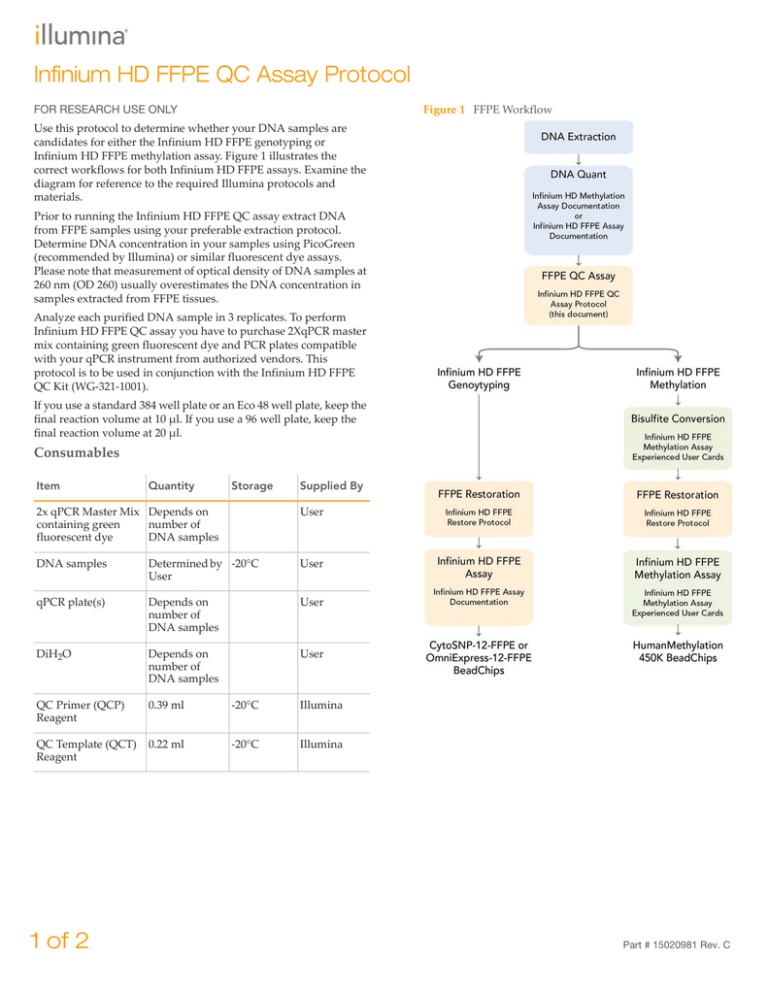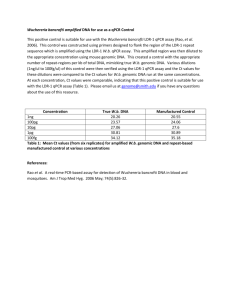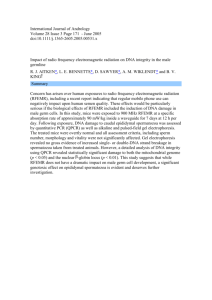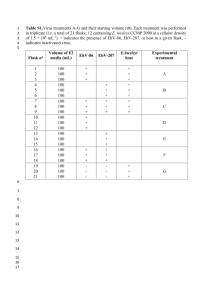
Infinium HD FFPE QC Assay Protocol
FOR RESEARCH USE ONLY
Figure 1 FFPE Workflow
Use this protocol to determine whether your DNA samples are
candidates for either the Infinium HD FFPE genotyping or
Infinium HD FFPE methylation assay. Figure 1 illustrates the
correct workflows for both Infinium HD FFPE assays. Examine the
diagram for reference to the required Illumina protocols and
materials.
Prior to running the Infinium HD FFPE QC assay extract DNA
from FFPE samples using your preferable extraction protocol.
Determine DNA concentration in your samples using PicoGreen
(recommended by Illumina) or similar fluorescent dye assays.
Please note that measurement of optical density of DNA samples at
260 nm (OD 260) usually overestimates the DNA concentration in
samples extracted from FFPE tissues.
Analyze each purified DNA sample in 3 replicates. To perform
Infinium HD FFPE QC assay you have to purchase 2XqPCR master
mix containing green fluorescent dye and PCR plates compatible
with your qPCR instrument from authorized vendors. This
protocol is to be used in conjunction with the Infinium HD FFPE
QC Kit (WG-321-1001).
If you use a standard 384 well plate or an Eco 48 well plate, keep the
final reaction volume at 10 µl. If you use a 96 well plate, keep the
final reaction volume at 20 µl.
Consumables
Item
Quantity
Storage
Supplied By
2x qPCR Master Mix Depends on
containing green
number of
fluorescent dye
DNA samples
User
DNA samples
Determined by -20°C
User
User
qPCR plate(s)
Depends on
number of
DNA samples
User
DiH2O
Depends on
number of
DNA samples
User
QC Primer (QCP)
Reagent
0.39 ml
-20°C
Illumina
QC Template (QCT)
Reagent
0.22 ml
-20°C
Illumina
1 of 2
Part # 15020981 Rev. C
Infinium HD FFPE QC Assay Protocol
Preparation
`
`
Measure the concentration of DNA extracted from FFPE
samples using PicoGreen or similar fluorescent dye assay and
dilute the DNA to a concentration of 1 ng/µl.
Thaw the QCP and QCT reagent tubes to room temperature
and vortex to mix the contents.
Note: If you plan to use QCT for multiple PCR runs, create 10 µl
aliquots of QCT in tubes labeled "QCT_ST" and keep them frozen
at -20°C. Use a fresh QCT aliquot for each PCR run. The original
box can accommodate at least 6 aliquots.
` Thaw the 2x qPCR Master Mix tube(s). The number of tubes
will be determined by the number of samples you are
analyzing.
Note: Take care to pipette accurately into the wells, as variations in
volume will affect the assay. Change tips after each pipetting step.
9
Seal the plate according to the manufacturer’s instructions and
briefly spin at 280 xg.
10
Make sure that the optical seal is clean from any liquid or dust.
Place the plate in the qPCR machine in the correct orientation.
11
Run the qPCR program using the following thermal profile:
Temperature Time
Steps
1
Take a fresh 10 µl aliquot of QCT and dispense 990 µl of
DiH2O water to it to create a 100-fold dilution of QCT.
2
Mix by brief vortexing and collect the droplets with a brief
spin at 280 xg.
3
For 10 µl reaction volumes:
a
Pipette 2 µl of the 100-fold diluted QCT from the
QCT-ST tube in 3 wells of the qPCR plate.
b Pipette 2 µl of genomic DNA (1 ng/µl) from FFPE samples
into 3 wells of the qPCR plate.
c
Pipette 2 µl of DiH2O water in 3 wells of the qPCR plate
for "no template control" (NTC).
4
5
X 40
50°C*
2 minutes
95°C*
10 minutes
95°C
30 seconds
57°C
30 seconds
72°C
30 seconds
*If required by the Master Mix manufacturer.
Analyzing Data
In accordance with the MIQE Guidelines for Real-Time PCR
experiments, Ct (threshhold cycle) will be referred to as Cq
(quantification cycle) as a quantification value.
For 20 µl reaction volumes:
a
Pipette 4 µl of the 100 fold dilution of QCT from the QCTST tube in 3 wells of the qPCR plate.
b Pipette 4 µl of genomic DNA into 3 wells of the qPCR
plate.
c
Pipette 4 µl of DiH2O water in 3 wells of the qPCR plate
for "no template control" (NTC).
1
Check the NTC wells for any amplification. There should be
zero to very inefficient amplification. Data is acceptable if the
amplification in NTC samples is >10 cycles after QCT_ST
samples.
2
Ensure that there is good amplification for all replicates and
remove any replicate Cq values that diverge by more than half
a unit.
Prepare the qPCR premix using the following table. Volumes
are per well of DNA sample (or control) you are analyzing.
Example: If you are analyzing 100 DNA samples in a 384 well
plate, you would prepare the qPCR premix for 337 replicates:
(306 replicates + 10% overfill). The final volume would be 337 x
8 µl of prepared qPCR premix =2.696 ml.
3
Obtain Cq values for all wells and compute average Cq values
for each FFPE and QCT_ST sample.
4
Subtract the average Cq value for QCT_ST from the average Cq
value for each sample to compute the Delta Cq value for each
sample.
5
All samples with Delta Cq value below 5 can be selected for
use with the Infinium HD FFPE Assay and the Infinium HD
FFPE Methylation Assay.
6
Proceed to the Infinium HD FFPE Restore Protocol (Part #
15020981 Rev. C) with your DNA samples and use the
Infinium HD FFPE QC Kit (WG-321-1001) to restore your
DNA samples.
10 µl reaction
volumes
20 µl reaction
volumes
2x qPCR Master Mix
5 µl
10 µl
QCP
1 µl
2 µl
DiH2O
2 µl
4 µl
Total volume added per well 8µl
16µl
6
Mix the qPCR premix container by inverting 10 times and tap
container on lab bench to collect the droplets.
7
Transfer the qPCR premix into a clean trough.
8
Using a multi-channel pipette (optional) dispense 8 µl (for 10
µl final volume) or 16 µl (for 20 µl final volume) of the qPCR
premix into each well containing gDNA, QCT, and NTC.
Part # 15020981 Rev. C
© 2011 Illumina, Inc. All rights reserved.
Illumina, illuminaDx, BeadArray, BeadXpress, cBot, CSPro, DASL,
DesignStudio, Eco, Genetic Energy, GAIIx, Genome Analyzer,
GenomeStudio, GoldenGate, HiScan, HiSeq, Infinium, iSelect, MiSeq,
Nextera, Sentrix, Solexa, TruSeq, VeraCode, the pumpkin orange color,
and the Genetic Energy streaming bases are registered trademarks or
trademarks of Illumina, Inc. All other brands and names contained herein
are the property of their respective owners.
2 of 2






